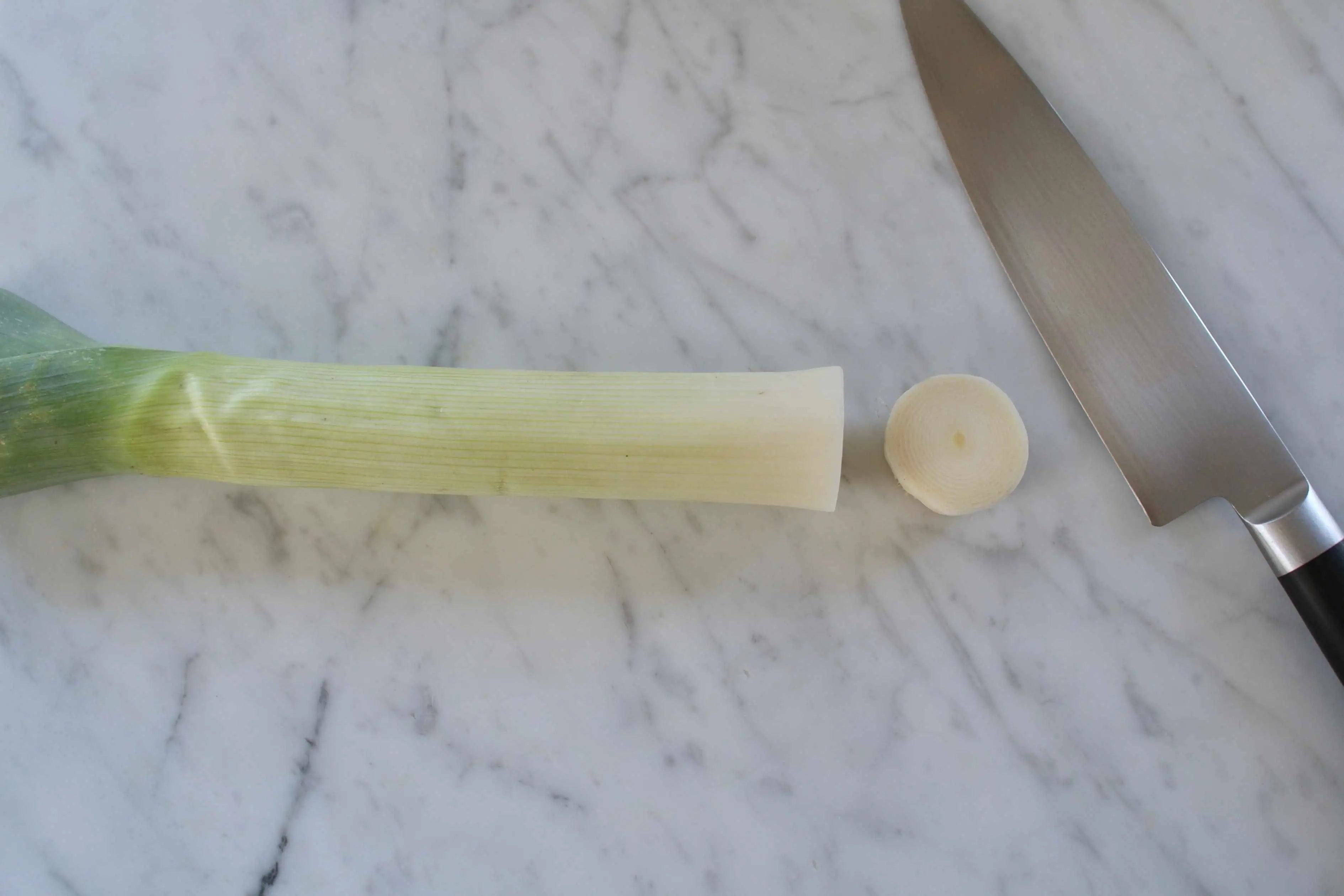TABLE OF CONTENTS
Despite its unique appearance, eggplant is actually incredibly versatile. You can bread it to make a cheesy eggplant parmesan as a vegetarian option for chicken parmesan. You can roast it, turn it into a creamy dip, or throw it into a ratatouille. Botanically a fruit in the nightshade family, eggplant can easily be used thanks to the mild flavor. It can act as a meat substitute, thanks to the texture, or cooked into a deliciously creamy dish.
However, before cooking, eggplant can look pretty daunting. It's got a weird texture, somewhere between foam and sponge, and its shape can make for a bit of a challenge if you want to cut everything uniformly. If cutting an eggplant has put you off of experimenting with this healthy dish, don't worry! Cutting into planks, cubes, rounds, and sticks can be done easily once you know how to tackle the whole piece.

Tools Needed to Cut an Eggplant
Before you tackle an eggplant, it's essential to have the right tools. For cutting eggplant, you'll want a sharp knife and a stable cutting board. If your cutting board isn't sturdy enough, try putting a damp rag underneath it on the counter for extra stability. The cutting board should be large enough to accommodate the size of the eggplant. Most people recommend wooden cutting boards because they are often sturdier and last longer. Plus, wood is naturally self-healing, meaning fewer marks on the board and more resistant to bacteria and dirt.
The knife should be sharp and large to help cut through the thickest parts of the eggplant. The best are a chef's knife, a santoku knife, or a serrated knife. Take your pick based on what feels best in your hand. In a pinch, you can tackle an eggplant with a smaller steak knife, but it is much easier if you pick up one of your larger kitchen knives.

Before Making Your First Slice
Before you ever make your first slice of eggplant, there are some considerations you will need to make. You have to select a good eggplant, free from blemishes and perfectly ripe. It doesn't matter how good your cutting skills are if the eggplant you've chosen is bitter, rotten, or otherwise unenjoyable. You will also need to prepare the eggplant for use in your dishes, which requires a bit of additional care. Then, with your ingredients and tools gathered and prepared, you will be ready to start cutting.
Choosing Your Eggplant
Before you can even think about cutting an eggplant, you have to pick out the right one. Choosing eggplants at the store is a simple task: The best eggplants are firm but soft enough to press. It should press down a bit when you press in, but spring right back out. They are a bit softer than a zucchini. Look for blemishes, especially around the stem, and skip over any that appear bruised, mushy, or moldy.
The skin of the eggplant should be smooth and glossy with a deep purple color. It should be tight, not wrinkly. The best eggplants are small to medium in size, with thinner skin, a more tender flesh, and often, fewer seeds. The seeds are likely to make the whole plant taste bitter.
Preparing the Eggplant
When you're ready to cut your chosen eggplant, there are a few steps to take before getting started. First, the eggplant needs to be rinsed in cold water. Please give it a quick rub to remove any dirt or debris, then gently pat it dry with some paper towel. If it's an older or larger eggplant, you'll probably want to remove the skin, which is likely to be thick.
To remove the skin:
- Cut off the top and bottom 1/2 inch from the eggplant.
- Stand up the eggplant on your cutting board.
- Use either a peeler or a paring knife to make a small incision at the top, just under the skin.
- Use the knife or peeler to remove the skin in long strips from top to bottom, rotating as necessary to remove all signs of purple from your plant.
Once washed and peeled, if necessary, it can then be cut into the final form you'll use for your recipe.
How to Cut Eggplant into Planks
Eggplant cut into planks is perfect to roast or bake. When eggplant is the main dish, it is commonly prepared in this cut. Many Italian and Italian-inspired dishes require these large slices of eggplant to be used as substitutes for pasta. You will also begin with planks when cutting both sticks and cubes.
If you want to peel your eggplant, do so before beginning your cuts. There are two ways you can do this. With shorter eggplants, the easiest way to do so is to stand it on the flat bottom, then slice from top to bottom in the thickness required by the recipe. If no thickness is suggested, default to about 1/2 inch slices.
For larger eggplants, place the eggplant on its side on the cutting board. Then, carefully cut down the fruit's length from one end to the next. You should have 1/2 inch slices when you are finished.

How to Cut Eggplant into Rounds
If you plan on using eggplant for sandwiches or as base layers for something, using rounds is often the easiest solution. This is also the shape you'll use for something like a ratatouille. To cut in this form. Thanks to the round shape eggplant naturally take, creating rounds is simple.
Hold the eggplant firmly on the cutting board. Use your non-dominant hand for this, as you'll be making your cuts with the other hand. When cutting toward your hand like this, make sure that you hold your fingers inward with nails pointed downward to protect fingers.
Take the knife and slice the top 1/2 inch underneath the stem. Then, start slicing across the eggplant to create the slices at the desired thickness. Remember that eggplant will shrink as it cooks, so plan accordingly! Very thin slices, unless called for, probably won't yield the results you're looking for.
When you've finished, toss the top and bottoms of the eggplant. These are often tougher and bitter, making them less enjoyable than the other cuts.

How to Cut Eggplant into Sticks
Eggplant sticks are made by taking your planks and cutting them further. Or, if you want smaller sticks, you can start with rounds instead. This is perfect for making stir-fry, eggplant tempura, or veggie fries. Just make sure to take care and keep the pieces in similar sizes so they will all cook evenly.
Start with your planks or rounds and place them into piles on your cutting board. They should be kept in similar sizes, so your slices are even. Then, hold the pile to keep them in place, carefully avoid any accidental cuts, and slice at 1/2 inch intervals to create sticks.
If you want to cut the eggplant into larger wedges, you can also cut the eggplant in half lengthwise. Then, with the cut side down, you can start cutting diagonally with the blade placed about 1 inch from the side. This will create a wedge, which you can move aside and then cut across at the 1/2 inch length increments to make your slices. Cut the first half, then move on to the second half to cut the same way.

How to Cut Eggplant into Cubes
Sometimes, you may need cubes for a recipe. Maybe you are sautéing chunks into a dish, or you want to make tacos. You can even toss small cubes on pizza. These cubes are great because they cook and soften quickly and absorb the dish's flavors. This makes them incredibly versatile. And, though it might seem a bit daunting to cut a whole eggplant into uniform cubes, all you have to do is add one more step to your planked eggplant.
To cut the eggplant into cubes, take your eggplant, cut the ends off, and create your 1/2 inch planks (or another thickness depending on the size of cubes you need).
When you have planked the whole eggplant, pile up the planks, keeping similar sizes together. Then, slice them into sticks by starting at one end and slicing down to the other, creating 1/2 inch sticks.
Holding your sticks together carefully, start cutting them crosswise into cubes of the same width as the length of the cubes. If your sticks are 1/2 inches, cut the cubes at 1/2 inches. Once you're done, you'll have your cubes ready to go.

Conclusion
Eggplant may seem challenging to prepare at first glance, but it's simple enough to process once you know what you're doing. Don't be intimidated by the irregular shape and size! Most recipes will begin with creating planks, rounds, sticks, or cubes out of your eggplant as a base. By following these tips for easy cutting of eggplant, you'll be an expert in no time, enjoying all sorts of delicious eggplant-based dishes.






















Leave a comment
All comments are moderated before being published.
This site is protected by hCaptcha and the hCaptcha Privacy Policy and Terms of Service apply.